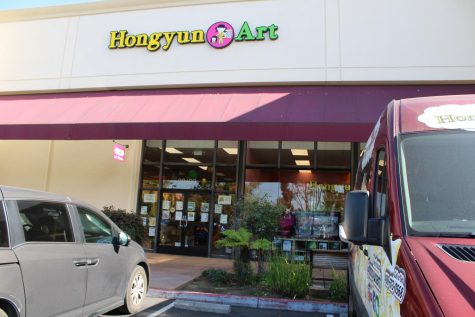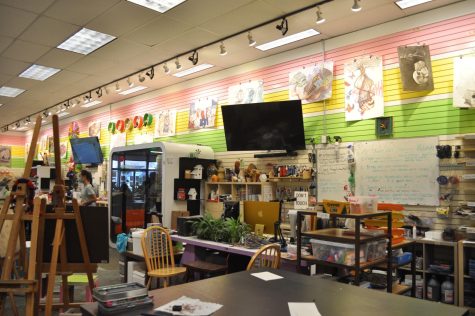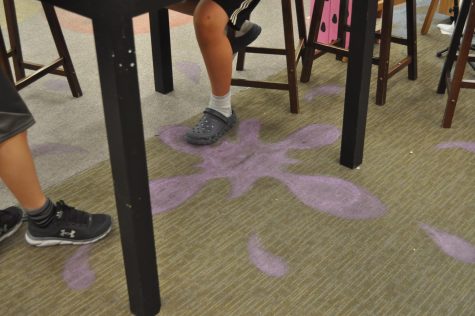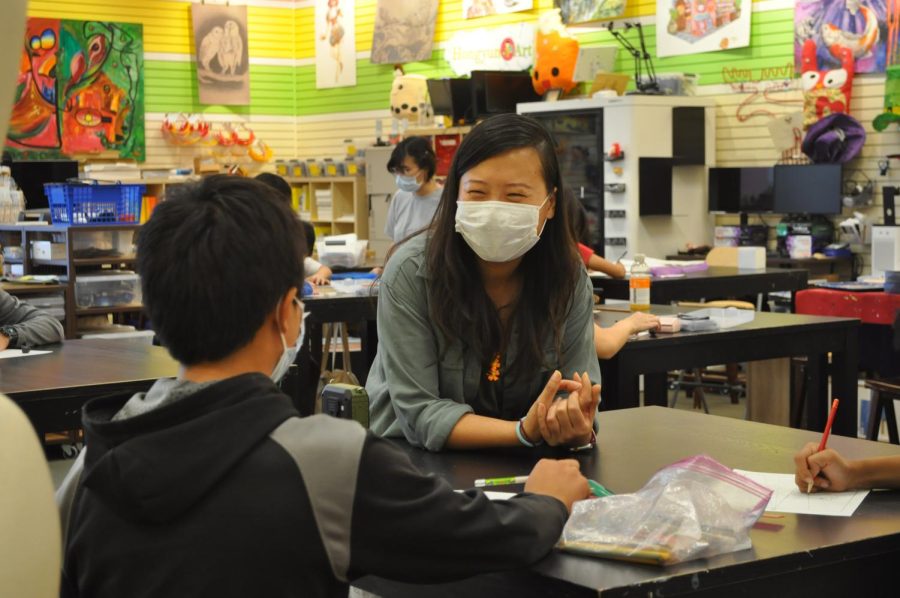Hongyun Art
June 11, 2022
The cloth of her drenched dress weighed down on her as she scanned her surroundings — students her age waiting as their parents held umbrellas over their heads. She on the other hand stood still, without even a raincoat to cover her. She felt out of place, scared and most of all, unpresentable. Gently lifting her canvas bag, she realized the art supplies she had bought with her red envelope money were now dripping with rainwater, unusable.
It was April, the rainy season in Shanghai, China, when 16-year-old Hongyun stood with her soaking shoes in a line with hundreds and thousands of other children. She had just come from Inner Mongolia, making this the second time she had run away from home: the first to canvas art colleges in Shanghai and this time, to take an enrollment test.
Hongyun had just enough money for a train ticket to and back from her college visits, with a total of “10 cents” in her pocket. She barely ate the entire trip and was living in a run-down motel with 12 other girls. She remembers that while standing in front of the train station, a homeless girl pitied her and eventually gave her “50 cents” after realizing that Hongyun had no money herself.
Now she was in front of Shanghai Theater Academy, her nerves eating at her as she timidly walked in. When the test administrators saw her drenched materials, they handed her dry paper and art supplies . As she walked into the exam room, she knew that she had to take advantage of this opportunity to the fullest. This test would determine her whole life.
Honyun was first introduced to the world of art by her grandpa. Long scrolls with traditional Chinese “山水” paintings lined the walls of his study room, decorated with potted flowers and accented with Chinese calligraphy brushes. He would sit in the center — his calm strokes animating an ink-borne tiger that stretched across the scroll. When she wasn’t getting him water to dip his brushes into, Hongyun sat next to him, watching him paint. She remembered thinking, “哇,好美呀,” — “Wow, how beautiful—” and would try to replicate his drawings. But while her grandfather had only pursued art as a hobby, Hongyun expressed that she wanted to pursue it beyond that. However, her parents were quick to shut her down.
“‘You are so disgraceful, you will be poor, on the end [of] the street and be homeless,’” Hongyun recalls her parents saying.
She had no other choice but to go to Shanghai on her own and take the test without telling her parents — pausing all communication with them. Her heart palpitated as she stood in front of a long winded poster that listed the names of each student that advanced to the next day — the test spanned a week, each day presenting a different task for the selected students to complete, ranging from realism to oil painting. After Hongyun completed the last day, she went home and collapsed on her bed for the entire day. Hongyun did eventually receive her acceptance letter from the Shanghai Theatre Academy— a prestigious college with a low acceptance rate, the one where “all the Chinese celebrities” were from. The college had a selective acceptance process, which would’ve given her an “iron rice bowl” job after graduation. However, during her fourth year, she felt that the atmosphere at the college didn’t suit her, and so she decided to immigrate to America.
When she arrived in America, Hongyun initially enrolled in De Anza College to refine her English, later transferring to University of California, Berkeley where she earned her master’s degree in fine art. After graduating, she was a part-time arts and crafts instructor at Eaton Elementary School. Feeling both unfulfilled and financially unstable in her new career, she decided to follow her mother-in-law’s advice and go into nursing, hoping to pursue a new and more conventional path in her family’s eyes.
It wasn’t until she threw up after seeing a cadaver, the pungent chemicals overwhelming her sense of smell, that she “realized [she] didn’t want to do this.” Hongyun promptly quit nursing school and gave herself two years to “do whatever [she] wanted to do.” She promised herself that if her endeavor failed, she would go back to nursing school.
She returned to art, her true passion Hongyun scrambled her resources together and opened a small art studio in her apartment — thus began Hongyun Art. To attract students, she and her husband Tommy designed small cut out ads that they posted on bulletin boards and printed out in the corner of newspapers.

What started with two students grew rapidly through word of mouth, and Hongyun’s classes were soon booked back to back, her dream manifesting in front of her when the two opened their first location on De Anza Blvd. However, De Anza already had a line of established and bustling art studios — Hongyun remembers her friends who also owned art studios asking if she was crazy for opening her studio on the same street as them, especially during the Great Recession of 2008. This cumulated into a general nervousness that accompanies every first endeavor, a constant worry about rent exacerbated by her other concerns.
“I had no choice because my one bedroom apartment could not hold all my students,” Hongyun said. “All my classes [were] packed and people were still on the waiting list — I had no choice; I had to open a bigger space. It was very tough in the first half year, I was very scared and I just wanted to make sure everything’s right.”

Hongyun and Tommy recall facing challenges everyday, the experience and time helping them “just get used to it.” Used to running an art studio by herself, Hongyun’s first major challenge was managing others. She also had to learn how to implement feedback training into her business and explore the physicalities of the studio as they became more resourceful — this helped when they opened their third studio, as the couple manually wired all their lights and painted their own walls. Hongyun cleverly painted splotches of paint on their carpet instead of replacing it and they upcycled an extra order of doors as tables for the studio, even using the chairs from a neighboring Chinese restaurant that was closing down.
Their hard work paid off, and their studio flourished. They soon moved into their second studio across the street from their first location in 2014. Hongyun Art moved to theCrossRoads Plaza in 2019 and focuses on hands-on creative art projects for students of any age. The owners attribute their choice to only have one studio open to their feeling that having multiple locations open at once would decrease the business’s authenticity and the personal feeling embedded into the name.
When recalling why her studio stood out and eventually thrived despite opening on a street of competing businesses, Hongyun laughed: “I never thought about why.”
Hongyun and Tommy eventually attributed it to their teaching style, their “whole mantra [being about how] art is not just about pretty pictures,” but rather the creativity and passion gained from each project. They don’t believe in training their students to be like “photocopying machines;” rather, they always foster their students’ imagination.

This translates through their teaching style, which includes stimulating their students’ creativity at a young age. Their art prompts have an open-ended nature, one of them being “how to send a cow to the moon,” which inspired drawings with colorful hot air balloons, spaceships and enlarged soap bubbles. With imagination, Hongyun emphasizes how there is “no right or wrong,” a concept she has seen parents unable to fully grasp.
“The honest truth is that [for the younger] kids, [their] brains are truly unlocked,” Tommy said. “As you get older people beat you down, like ‘No, that’s wrong, you can’t do that, that’s wrong and that’s wrong.’ And our job is to keep that open minded thinking alive as long as possible.”
The two also value developing personal connections with their students, making conversation about their life beyond art class — from how their week went to boyfriends or girlfriends and prom — to the point where Tommy describes it to be “like therapy.”
Hongyun emphasizes how instead of treating art as a skill, she presents it as a tool to “create new ideas and interact with each other.” The way her studio is set up with these core ideals, implementing different activities and systems that support her students.
“I use art to help kids create,” Hongyun said. “And after that, you use that to help other people.”
One program Hongyun Art uses is the Teacher’s Assistant (TA) program where students take on the role of a mentor for younger kids, because “sometimes the best way to learn is to help other kids [because they can] trigger another perspective” and improve one’s leadership skills.
Stemming from Hongyun Art, the Hongyun Art Foundation was created to give back to the community, facilitating comic workshops in Cupertino Library, senior home visits and utility box paintings across the city.
The program Hongyun is the proudest of is the Global Education Initiative (GEI). Started in the spring of 2017, the GEI revolves around international trips where Hongyun Art students visit foreign nations and help students develop their inner creativity as well as training teachers on how to utilize and take advantage of their resources — at its root giving their students more creative freedom while fostering core skills. They paused the GEI program because of COVID-19 but plan to continue it sometime this year. They’ve visited Denmark, Japan, Singapore, Korea and Thailand — the most memorable being Myanmar because of the stark differences in living conditions that brought awareness to the omnipresent privilege that the students carry with them as they return back to America.
Hongyun and Tommy recounted their stories from the GEI program — enough to make a story of itself — reminiscing on the chaos of their first trip: the language barrier, uncoordinated taxis which they solved on future trips by renting out a bus and general shock and unpreparedness of how to teach in this new environment. Their stories were laced with joy and laughter, the two of them immersed in their own world as they re-lived every trip, each person building onto the other with more details that they dug out from their core memories.
To them, Hongyun Art is more than an art studio — it’s a family where the teachers and students are all learning together. Students come in as toddlers and advance up the levels until they graduate. The owners mention their alumni frequently, describing how they still come to visit, a sense of pride reverberating in the two’s voices while they boast their past and current students’ accomplishments and recount the experiences they had through teaching them.
“It’s hard for people to wrap their brain around, but for us, art is a way of seeing the world,” Hongyun said. “A lot of art schools teach you how to draw a vase of flowers and a statue [and] we can do that too — that’s fine. It’s just more interesting [to ask] ‘what do you want to draw? Why do you want to do it? What can we unlock for you that makes you more motivated? What can we do to make you guys more driven to do crazy stuff [and] attempt crazy projects that are fun?’ That’s fundamental [and] we’ve been tinkering [to] do the right thing that makes it a better experience for everybody. My goal is now to create awesome humans, little human beings, and send them off to the world and see what they can do.”

